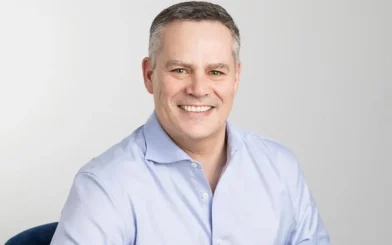


Brian Sands
Founder and Managing Director, Oxygen Risk
Now, more than ever, companies are encouraged to pay close attention to strategy orientation and risk management in order to stand out, and retain relevance.
With a growing focus on sustainability at the forefront of businesses the world over, and the increasing volatility of markets, mindful business strategy has never been more prevalent.
Brian Sands is the founder of Oxygen, a strategy and risk advisory firm with a construction specialty.
With a career spanning over 20 years, Brian uses his industry experience to provide in-depth analysis and intervention for businesses looking to optimise and maximise projects.
We chatted with Brian about his journey through the construction industry, the prevalence of risk management, and his advice for those looking to follow a similar career path.
Brian, you’ve had a long and varied career within construction. What were some of the key learnings you picked up along the way?
Whilst technical construction experience was and always is an important foundation for success, acknowledging that people are the ultimate enablers, and indeed, disablers is a key learning that is still top of mind for me today.
You need people that can, know and want. What I mean is surrounding yourself with people that are capable, aligned and engaged.
Too often businesses stop at technical capability, and then alignment and engagement become a cultural compromise, rather than an imperative.
This reminds me that these key learnings came for me through some great mentors. Probably a key learning in itself; find some mentors and start seeing and thinking differently.
How did you progress into more senior roles?
Quite simply, it was via hard work and grabbing every opportunity to be exposed to new skills.
Over the initial 20 years I progressed through almost every conceivable role from site labourer to business owner of a $100M+ contractor and a $200M joint venture.
There were no opportunistic door openers, it was more about immersing myself 100% in everything I did and ensuring successful outcomes as opposed to just getting it done.
And I have always had an interest in meaningful professional development to support a specific career path, something I continue to do, even as late as a couple of months ago.
I don’t believe you can turn this drive on and off, it needs to become part of your DNA.
Today you’re the managing director of Oxygen, an advisory firm you actually started in 2015. What made you take that path?
I was the Managing Director and major shareholder of a successful tier two construction firm, and having dusted ourselves off after completing a successful and pretty aggressive post GFC turnaround strategy, I decided that I had the skills and experience to then become a fly-in-fly-out problem solve interim management type of proposition – a hands-on intervention, supporting other businesses through risk and opportunity.
I like the challenge of creating strategies and the reward of solving problems.
You outline that your point of distinction is based on four key perspectives which all speak to the experience you’ve gained in your career. Can you walk us through these four perspectives?
It demonstrates diversity around experience, it’s my way of describing the value that I bring to these type of engagements, that there is more value to be added outside of a one-dimensional construction guy. The 4 points of distinction are:
- Technical perspective – the Registered Builder Practitioner having built a lot of projects
- Executive perspective – the senior roles owning and managing construction businesses
- Practitioner perspective – the current management consultant/corporate advisory role
- Academic perspective – having wrapped up 25 years experience into a recent Masters
Degree to provide updated learnings, models and credibility to what I do.
So Oxygen is a strategy and risk advisory firm specialising in construction, tell us a bit more about what kind of work you do.
It is interim management. Short-term gigs, usually two at a time in a non-compete environment, solving a particular problem.
Some very recent examples include:
- A structured wind-down and exit of a loss-making Australian-based subsidiary of a New Zealand Construction company,
- A project risk advisory role in relation to a $100M+ Brisbane project that was ‘contractually sideways’ and headed for litigation,
- Facilitated a negotiated outcome and pre-completion exit between developer and builder on a $50M Sydney project,
- An interim Construction Director gig for a global student accommodation developer expanding throughout Australia,
- Other short term strategy origination gigs – biometric technology out of the UK, global procurement for student accommodation, construction business unit expansion.
If someone was interested in following a similar career path to yours, what advice would you give them to get there?
- Be very clear about what it is you want to do and the steps that you need to take to get to that point.
- Do your research around the people in that field or potential organisation. Seek out the people that will help you get to where you think you want to get to. Don’t just chase a name on a crane.
- Take a medium or long term view with flexibility in terms of collecting experience and how you get there. That is, take it all on. Don’t fix on one path too early. Keep your options open.
The industry’s obviously undergone some changes since you first started out, and even since you first started your business. What are some of the most exciting innovations you’ve seen in construction?
There are definitely some great things happening in modular and prefabricated construction, however I think the excitement is in what’s coming in predictive analysis and how that could quantify risk, way ahead of time.
The global industry is plagued with bad press around time and cost risk events, and predictive analysis technology may be the answer.
For example, I have seen a pilot program in Europe where a drone can collect detailed data that creates a graphic that illustrates as-built progress, that in turn informs cost to complete and progress claim assessments.
Not to mention providing information around progress and quality-related risk assessments, in real time.
Another example on a drawing board or computer screen somewhere is a program that will ‘mine’ live data contained within project correspondence. It will tie words, phrases and even sentiment together so that machine learning will predict likelihood and quantify with dollars, every conceivable risk event.
For someone looking to take the next step in their construction career, what’s the one thing that a candidate can do in your eyes that sets them apart?
Don’t tell me about the job they want or the salary they are expecting.
Firstly, tell me what skills and experience they have and how that will add value to me, regardless of how extensive or not. Give me a picture around value creation.
And secondly, suggest what experience and exposure they think that I can provide them that will enhance their proposition.
Give me a point of difference “from my perspective” so that I can get excited about the job I could provide, and the salary I could offer.
Want to be seen by powerful personalities like Brian? Create your free Conecta profile today to expand your opportunities.
Recent Jobs
Recommended posts


Recent Jobs
Download the 2023 Salary Guide
Over 20,000 construction professionals stay connected to industry with Conecta
